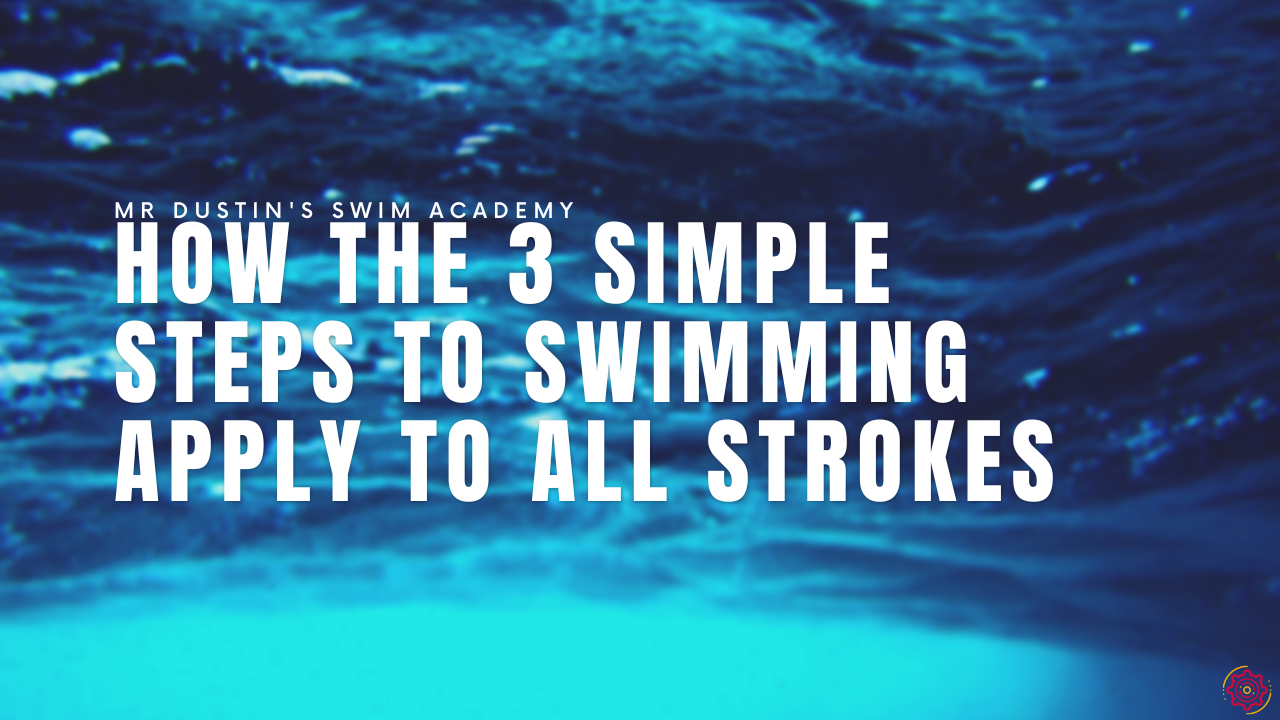Early in my swim teaching career I created a system I call the "3 Simple Steps to Swimming" or "3 Steps to Swimming" for short.
These three steps were the most basic explanation of what you need to do physically in order to actually swim. They do not include breathing technically, as that is more of an add on movement to swimming. As without the base movement and momentum, then you won't be able to get air in the first place.
The 3 steps are what I teach all of my students, regardless of age or skill, as they are essentially a mnemonic to help you WHILE you swim.
What are the 3 Steps to Swimming?
- Kicking Legs Straight
- Face Down
- Arms out of Water, Diving Back In
Now each word is specifically chosen, and sometimes I skill the "of water" part of step 3, but for the most part; Each word of the steps, and the order of the steps are very important to respect the placement of. As they compound when you are in the water.
Why are they so important to Master?
First and foremost we don't want to drown right? Thus we need to learn the basics to keep ourselves able to go to the wall when in desperate need.
The 3 steps are basic enough that if you simply kick your legs straight (and not a doggy paddle-like bending of the knees), then you should make it to the side of the pool/shore almost every time.
Kicking propels you so much, and then the arms accelerate you. However without having the face down in the water then you hinder your other two parts.
With your face up you force your spine to bend in a bad way, which causes your feet to be forced downward. Meaning even if you are kicking perfectly, they won't help you as much.
It also prevents your arms from having a full range of motion, as your neck blocks the shoulders from moving as much with your face/head UP.
Let's start off with how they apply to FrontCrawl!
Since they were made with Frontcrawl in mind, as to simplify the physical learning of the stroke. They fit quite well into the form.
Your kicks should be straight, and kicking consistently.
Your face will be down in the water, and more advanced swimmers will even put their chin down.
Then your arms will be coming out of the water, and you want to dive your hands in. As if you smack the water you are wasting too much energy on the surface tension. You might think though that by diving you miss out on extra water space you could have been pulling. Well a more advanced technique for the Step 3, is once you dive in, then you reach and pull. By reaching you will regain that lost space.
How do they apply to breaststroke?
Now the biggest difference is how the wording applies to this underwater stroke. Instead of "arms out of the water", it is shortened to just "arms out". As you will be reaching horizontally OUT with your stroke.
The kicks turn into a frog style kick, however once you have done your propulsion with your froggy kick. Then they have to straighten back out, in order to reset to kick again. As well as to attain a bit of a streamline glide from the kick's movement.
Your face still is down during this, but will come up during breathing strokes.
How do they apply to Backstroke?
It is essentially the same as front stroke/frontcrawl, as your arms come out, and dive back in. The legs are exactly the same!
The one key difference I'd say is the face, as the "face down" aspect can be interpreted in one of two ways. You can have your face going down in the OTHER way. Meaning your forehead goes down rather than the chin, so you LOOK UP, but your face is still going down. Then you could theoretically change the step to just "face up", but that might be confusing.
How do they apply to Butterfly?
Well if you think about it like this: butterfly is just DOUBLE FRONT CRAWL.
Instead of your legs kicking in a scissor pattern, they both kick at once, but they still kick straight. You shouldn't bend your knees for a proper dolphin kick.
Your face stays down, and in fact its ever more important with this stroke. As your arm mobility is needed even more.
Finally, the arms instead of going one at a time, they both come out of the water at the same time. It is essentially the same pattern too in how they come out, and go back in. Just that they both need to move in sync.
Thus the 3 steps is unchanged for butterfly.
Okay so what do I need to do in order to master the 3 Steps then?
The first thing is to simply repeat them out loud and in your head as much as possible. Just like you would learn anything, you have to mentally get it first.
I always have my students verbally repeat them back to me, as it helps cement the idea more in your head.
Write them down even.
They are simple at least, and if you mess them up; Then that is the point. So that while you are swimming you can go in your head to figure out what you are messing up on WHILE you swim. In the moment.
You can think 1, 2, 3, or 1 legs, 2 face, 3 arms.
![Official Website for Dustin Miller PolyInnovator [LLC]](https://polyinnovator.space/content/images/2025/03/polyinnovator-logo-2024.png)











